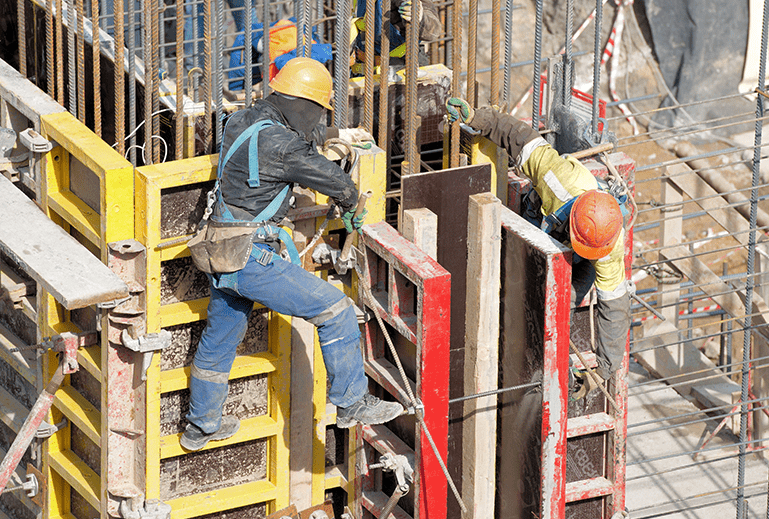
Ilkecelik/123rf
When it comes to working at heights trends and advancements in Canada, changes have been made at a slow, steady pace. In general, the trends and advancements have been for the betterment of the fall protection wearer, usually focusing on increasing comfort and safety. Some of the most notable recent trends include training standards set by the Ministry of Labour in Ontario, advancements in equipment and increased enforcement.
Ontario’s Working at Heights Training Program
Working at heights accidents are unacceptable and preventable. Through approved training programs from sanctioned providers, the Ministry of Labour aims to reduce fall injuries and accidents from heights that are resultant from a lack of quality training. The Working at Heights Training Program Standard comes in response to an intolerably high number of working at heights accidents and fatalities reported in Ontario.
The Ministry of Labour’s website states the purpose of the Working at Heights Training Program Standard as follows:
The purpose of the Working at Heights Training Program Standard is to establish a mandatory minimum standard for high quality and consistent training for workers who work at heights in the Province of Ontario.
The purpose of a working at heights training program that meets the requirements set out in this standard is to:
Strengthen workplace safety culture by elevating the profile and importance of preventing falls from heights
Provide workers who may be exposed to the hazard of falling with adequate knowledge about fall hazards and general safety practices to work safely at heights
Provide workers who use personal fall protection equipment with sufficient knowledge about its purpose and use
Reduce the number of fall-from-heights incidents, injuries and fatalities1
The Ontario Ministry of Labour’s training standard for working at heights is not meant to replace the working at heights legislation or the Construction Regulations. The goal is to have it supplement and support the legislation and Regulations by ensuring that the training adequately educates learners about working at heights hazards and appropriate controls.
Advancements in equipment
According to women who wear them, and judging by the fit and style, fall protection harnesses were not designed with female workers in mind. Thankfully, most harnesses come in a variety of sizes, so that women can purchase one that fits them best. While there hasn’t been a ton of advancement for women who have to wear harnesses, Honeywell Miller (a major manufacturer of fall protection equipment) has introduced the MS Honeywell-Miller line, designed for women. The MS Honeywell Miller H-style harness is designed to keep shoulder straps to the side and away from the chest. This style will help to reduce breast discomfort when wearing a harness, provided it is worn correctly.
Another exciting advancement in fall protection equipment includes a change to the webbing material, to add moisture-wicking technology that increases the life expectancy of harnesses and decreases the likelihood of failure in the event of a fall. Technology to decrease the weight of Self-Retracting Lifeline technology also aims to make life-saving equipment more wearer-friendly.
The introduction of a the new standard, ANSI Z359 will allow the use of metal alloys, provided they comply with load requirements. This is noteworthy because it may mean that D-rings, currently manufactured using heavy metal, can be constructed using much lighter weight alloys, such as aluminum. Using alloys will decrease the weight of the overall harness, making it both more comfortable and less physically taxing to wear. Although ANSI is an American standard, it still indicates forward movement in working at heights equipment advancements. It will be interesting to see whether or not Canadian legislation changes in response to ANSI Z359.
Increasing the comfort and wearability of fall protection equipment impacts the likelihood that equipment will be worn. The most oft-cited reason for not donning PPE is comfort. The trend toward making fall protection more comfortable for the end-user indicates that better wearability is a growing trend when it comes to working at heights.
Increased enforcement
In order to ensure compliance with all new initiatives and standards, the Ministry of Labour in Ontario has hired additional inspectors. Increased enforcement is an inevitable trend; enforcement and review ensure that the systems, standards and technology put in place are effectively keeping workers safe. Continuous improvement is the goal, and any failures or inefficiencies need to be examined and corrected. Increased enforcement isn’t about handing out more fines; it’s about ensuring that the system works in order to maximize the number of lives saved.
Looking ahead
When it comes to trends and advancements regarding working at heights, movement has been exciting, yet slow. Looking ahead, it’s hard to say where these exciting changes and innovations will lead; however, it’s safe to say the most exciting trend is reduced accidents, injuries and fatalities as a result of work from heights. ![]()
Reference
www.labour.gov.on.ca/english/hs/pubs/wah/purpose.php
Jenn Miller is the curriculum development coordinator for Occupational Safety Group (OSG) in London, Ont. She has a Bachelor of Arts Degree in literature from the University of Western Ontario and has over a decade of curriculum development experience. She is responsible for creating and editing various forms of health and safety content for OSG. Her professional goal at OSG is to make health and safety information accessible so that workers return home to loved ones each and every day. For more information, visit www.osg.ca.
-
New construction certification available for Chance® helical piles
April 25, 2024 -
An Alternative to Concrete
April 25, 2024 -
Donald Bailey’s Bridge
April 23, 2024 -
From Historic Foundations to Modern Marvels
April 18, 2024 -
Canadian Construction Trends for 2024
April 16, 2024